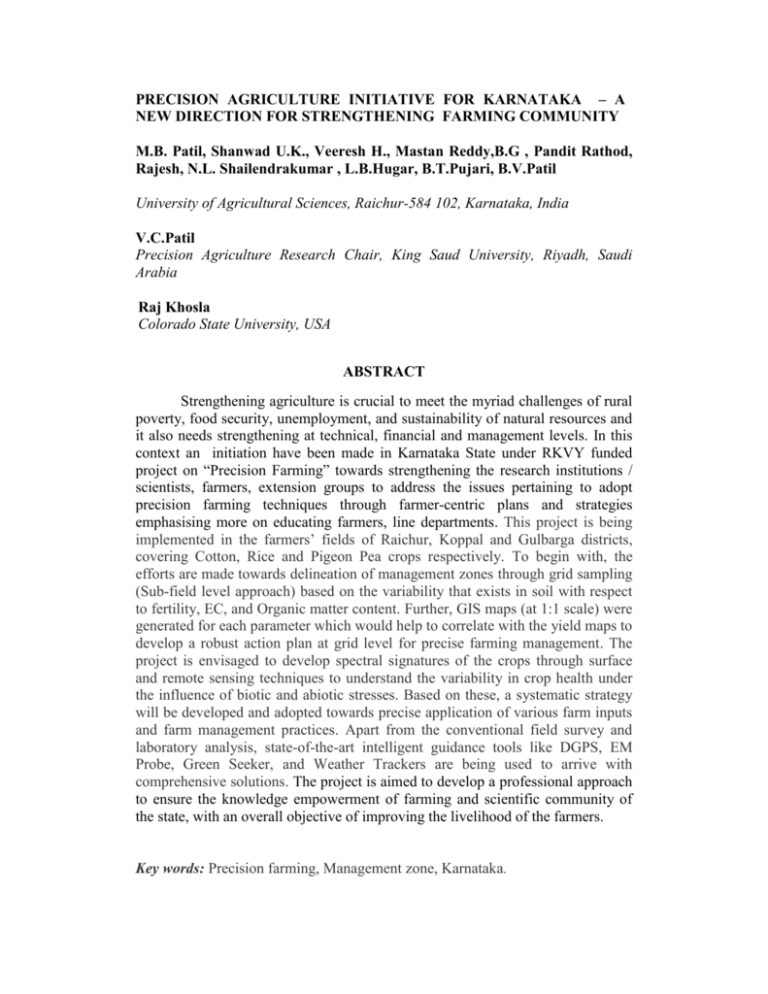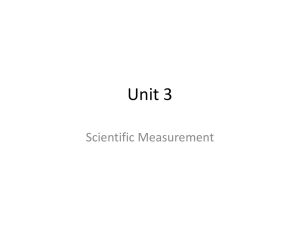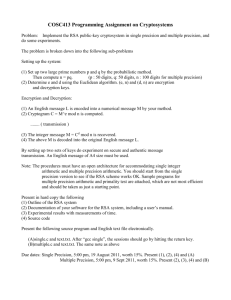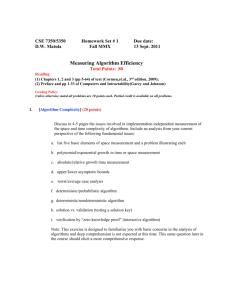PRECISION AGRICULTURE INITIATIVE FOR KARNATAKA – A
advertisement

PRECISION AGRICULTURE INITIATIVE FOR KARNATAKA – A NEW DIRECTION FOR STRENGTHENING FARMING COMMUNITY M.B. Patil, Shanwad U.K., Veeresh H., Mastan Reddy,B.G , Pandit Rathod, Rajesh, N.L. Shailendrakumar , L.B.Hugar, B.T.Pujari, B.V.Patil University of Agricultural Sciences, Raichur-584 102, Karnataka, India V.C.Patil Precision Agriculture Research Chair, King Saud University, Riyadh, Saudi Arabia Raj Khosla Colorado State University, USA ABSTRACT Strengthening agriculture is crucial to meet the myriad challenges of rural poverty, food security, unemployment, and sustainability of natural resources and it also needs strengthening at technical, financial and management levels. In this context an initiation have been made in Karnataka State under RKVY funded project on “Precision Farming” towards strengthening the research institutions / scientists, farmers, extension groups to address the issues pertaining to adopt precision farming techniques through farmer-centric plans and strategies emphasising more on educating farmers, line departments. This project is being implemented in the farmers’ fields of Raichur, Koppal and Gulbarga districts, covering Cotton, Rice and Pigeon Pea crops respectively. To begin with, the efforts are made towards delineation of management zones through grid sampling (Sub-field level approach) based on the variability that exists in soil with respect to fertility, EC, and Organic matter content. Further, GIS maps (at 1:1 scale) were generated for each parameter which would help to correlate with the yield maps to develop a robust action plan at grid level for precise farming management. The project is envisaged to develop spectral signatures of the crops through surface and remote sensing techniques to understand the variability in crop health under the influence of biotic and abiotic stresses. Based on these, a systematic strategy will be developed and adopted towards precise application of various farm inputs and farm management practices. Apart from the conventional field survey and laboratory analysis, state-of-the-art intelligent guidance tools like DGPS, EM Probe, Green Seeker, and Weather Trackers are being used to arrive with comprehensive solutions. The project is aimed to develop a professional approach to ensure the knowledge empowerment of farming and scientific community of the state, with an overall objective of improving the livelihood of the farmers. Key words: Precision farming, Management zone, Karnataka. INTRODUCTION Increasing production in all spheres is imperative to meet the growing demand of the population in India in terms of food, fodder, fiber, fuel, timber and industrial raw materials. The need is increasing to produce more and more from less and less of land and water both in quantity and quality; and time. The agricultural production is no longer profitable despite higher investment. The efforts made so far were generally concentrated in improving the crop productivity on a single crop/ enterprise basis without much attention towards the associated areas that support or influence the crop growth (system as a whole). The declining sustainability of the agricultural systems in India can be traced to the exploitation of resources without conservation for sustenance and profits. An approach in a system basis is the need of the hour for overall sustainable development. The aspects of efficient use of resources with conservation, growth with equity and sustainability are the difficult tasks to accomplish given the background of agricultural diversity and stubborn traditions attached to agriculture in India. Although India has made considerable advance in agricultural research, but still the blanket recommendations of fertilizers for adoption over larger areas are in vogue. These blanket recommendations are no more useful to enhance productivity gains, which were witnessed between 1960’s and 1980’s. Now, to enhance growth rate in productivity, precision farming technology has to be developed. Precision farming is important because: (i) nutrient variability within a field can be very high affecting optimum fertilizer rates, (ii) yield potential and grain protein can also vary greatly even within one field, affecting fertilizer requirement, (iii) increasing fertilizer use efficiency will become more important with increasing fertilizer costs and environment concerns, (iv)irrigation at critical stages is very important and (v) pest and stress management at early stages helps the farmer to get maximum yield (V.C.Patil, 2009 and Mondal ,2011) . Karnataka state forms the South Western part of the Deccan Peninsula and lies between 11.5°and 18.6° North latitude and 74.0° and 78.4° East longitudes. It is the 8th largest state in the country having an area of 191,791 Sq. Km (6.25% of India’s total area of 3,065,027 Sq. Km). According to the 2001 census, farmers and agricultural laborers formed 56% of the workforce of Karnataka. The State is divided into 10 Agro-climatic zones on the basis of soil structure, humidity, elevation, topography, vegetation, rainfall and other agroclimatic factors (Ramaswamy, 2006). The state of Karnataka now has four State Agriculture Universities of which the recently established [2009] UAS, Raichur is mandated primarily to focus on North-Eastern Karnataka region covering the districts of Raichur, Bidar, Gulbarga, Koppal, Bellary and Yadgir with about one-fourth of the state geographical area. The average per hectare consumption of N.P.K. nutrient is 52 kgs in the region as against 62 kgs in the state. Consumption of nitrogenous and phosphate nutrients has steadily increased in the area of cereals & pulses, where as potash consumption has become stagnant over last three years. The University has taken the lead in Karnataka by embarking a project on Precision Farming under the guidance of Dr. Raj Khosla , Professor of Precision Agriculture & Extension Specialist, Department of Soil and Crop Sciences, Colorado State University , USA and the President - International Society of Precision Agriculture . In this context, an initiation has been made in Karnataka State , a National Agriculture Development Project Plan (RKVY- Rastriya Krishi Vikas Yojana), Government of Karnataka funded project on Precision Farming in selected field crops namely, paddy, cotton and pigeon pea the major crops of the area on farmer participatory basis is in operation since 2011 in all the three State Agriculture Universities. UAS, Raichur is the lead centre to guide and monitor the project activities in other two universities of the state at Dharwad and Bangalore. Research and demonstration trials are undertaken on farmers’ fields and university research farms. ‘Farmer Centric’ approach as the focal point of this project , therefore the process of development begins at the farm. It is aimed towards strengthening the research institutions / scientists, farmers, extension groups to address the issues pertaining to adopt precision farming techniques through farmer-centric plans and strategies emphasising more on educating farmers, line departments through series of capacity building workshops, field demonstrations, on farm trials and institution based trainings. A Precision Agriculture Research Laboratory is being set up at College of Agriculture, Raichur under UAS, Raichur and a course on Precision Agriculture to post graduate students is being offered from 2011. Initially the project is envisaged to assess the spatial variability in the agriculture research farm of UAS, Raichur and as well as in the selected farmers’ field with the following objectives; To adopt and demonstrate precision farming techniques for paddy, pigeon pea and cotton Adopt appropriate precision farming machinery/equipment to increase the input use efficiency Impart training to the farmers and the officials of the line departments and extend advisory services on precision farming techniques. MATERIALS AND METHODS Study Area This project is being implemented during Kharif-2011 at UAS, Raichur on four farms under 8 experimental plots and also in the farmers’ fields of Raichur, Koppal and Gulbarga districts (Fig.1), covering Cotton, Rice and Pigeon Pea crops 6° and 36° N, and 68° and 98° E. Coordinates : 15 .09‘ and 16 .34‘ N and 75 .46‘ and 77 .35 ‘ E Two major rivers Krishna and Tungabhadra The general slope from the north-west to the south-east 11°30' and 18°30' N 74° and 78°30' E MSL : 1,311 feet Fig.1. PROJECT AREA UNDER UAS, RACIHUR JURISDICTION On research farms, one ha area each of precision and non-precision [farmers’ practice] as check were laid out and crops were raised for effective comparisions. Grid based soil sampling and crop growth observations The surface soil samples (0-20 cm depth) were collected on grid basis i.e., 10X10m at research farms and 50X50m at farmers’ plots to assess the spatial variability on soil fertility status. The exact sample location was recorded using a DGPS (Make: Trimble GeoXH). Processed soil samples were analyzed for various parameters such as pH, Electrical Conductivity (EC), Soil Organic Carbon (OC), N, available N, available P2O5 and available K2 O. During the crop growth period, the periodic observations were made (grid wise) on germination percentage, plant emergence, physiological maturity, pest and disease incidence and yield. Development of Variable Rate Application Strategies Variable rate of input application was made based on Soil Test Crop Recommendation approach. This emphasizes the application of fertilizer nutrients to each crop as per targeted yield and also considers the soil analysis results. The equations developed by AICRP on STCR which are unique for each crop, soil type and climatic conditions were used. Therefore, each grid area received variable rate of NPK applications depending on the initial soil nutrient status, thus minimized the probability of grid areas with high soil test values receiving higher doses of nutrient inputs and vice-versa which is a common impediment under blanket application of fertilizer inputs. For example: STCR equation as recommended by AICRP for Hyderabad – Karnataka region. (Ramamoorthi et al.,1967) Crop: Pigeon pea; Target Yield: 18 q/ha FN=5.61T-0.54SN; FP2O5=5.72T-4.73SP; FK2O=6.33T-0.17SK The details of area and crops with grid size and numbers are given below (Table 1 and Plate 1). Either on the farm and/or on the farmer’s fields wherein, the number of grids did not match the exact area specified due to loss of land area because of bunds and farm paths. Table 1: Details of experimental plots at on-farm (UAS, Raichur) and at Farmers’ field Sl. No. 1 2 Crop Variety /Hybrid COTTON [Bt] Dr.Bent, Kanaka, Raasi PADDY [Sona Mahsuri] Place Farm / Farm ers Village Precision/ Non Precision Raichur Farm Raichur Precision Non precision Marichethal Farm ers Marichethal Bhimaraya nagudi Farm Bhimarayana gudi Raichur Farm Raichur Farm Gangavati Farm ers Jangamara Kalgudi Gangavati Raichur Farm Farm 3 PIGEON PEA [TS-3R] Raichur Gulbarga Chinamgera Gulbarga Afzalpura taluka Farm ers Ingalagi Chowdapur Plot No AREA (Acre) No . of Grids Grid Size No. of Farmers 163 2.50 80 10 x 10 m 162 2.50 81 10 x 10 m 125 125A 126 126A 20.62 16.25 18.12 37.50 33 36 29 60 50 x 50 m 50 x 50 m 50 x 50 m 50 x 50 m 07 1 1.80 72 10 x 10 m ------- 2 0.125 05 10 x 10 m ------- 229 1.90 76 10 x 10 m ------- B-9 2.25 90 10 x 10 m ------- B-11 2.25 90 10 x 10 m ------- 125 126 37.50 27.50 60 44 50 x 50 m 50 x 50 m 28 Precision 127 13.125 21 50 x 50 m Precision Non precision Precision Non precision Non precision Non precision Non precision Precision 136 2.50 90 10 x 10 m ------- 146 2.50 90 10 x 10 m ------- B-4 1.25 50 10 x 10 m ------- C-2 1.10 44 10 x 10 m ------- C-3 1.10 44 10 x 10 m ------- 1 15.62 25 50 x 50 m 2 30.00 48 50 x 50 m 3 13.12 21 50 x 50 m Precision Non precision Precision Precision Non precision Precision Precision 4 15.00 24 50 x 50 m 1 15.62 25 50 x 50 m 2 3 22.50 10.00 36 16 50 x 50 m 50 x 50 m 1 8.12 13 50 x 50 m 2 3 2.50 5.00 04 08 50 x 50 m 50 x 50 m Precision Precision Non precision Non precision Precision Non precision Precision Precision ------- 11 Plate 1: Experimental plots of cotton, pigeon pea and paddy under precision farming project at UAS-R research farm RESULTS AND DISCUSSION Variability in Yields of crops Grid-wise systematic observations on crop growth parameters and yield were recorded. The yield variability within the area of one hectare (10X10 meter grid in UAS-R research farm) and as well the yield variability as observed in the farmers’ field (adopted 50X50 meter grid) are presented here. The results revealed that the grid wise spatial variability exists among yields of the crops. Ironically, the plots with adoption of STCR approach were also shown the significant variations among the grid wise yield (Table 2). This indicated that the corrective measures can only be adopted with rigorous analysis of various yield limiting factors and not just by adopting corrective measures for soil. Therefore, as advised by the international consultant on precision farming, Prof. Raj khosla, the first 2 years will be kept for observing the spatial variability under the conventional practice and thereafter derivation of management zones can be done with the help of Geostatistical and Geospatial Technologies. However, the variability recorded among the crop yields are presented here, the highest yield in cotton is obtained in precision plots was 3500 Kg/ha and the minimum was 800Kg/ha. In paddy, the highest yield (10790Kg/ha) was recorded at farmers’ fields and the least (4820Kg/ha) was in the research farm and in pigeon pea, the range of yield levels was between 680 to 1401 Kg/ha with highest yield recorded at farmers’ fields. The GIS maps of the spatial variability in yield levels of cotton, paddy and pigeon pea at precision plots [on farm] are given [Fig. 2, 3 and 4]. Table 2: The yield data of project area in different crops Sl. No. Crop Name Type Non-Precision 1 Cotton Precision Station Name Raichur Raichur Farmers Marichethal Farm Farm Farm B'Gudi Gangavati Gangavati Non-Precision Precision Gangavati Precision Gangavati Farmers Jangamaraka l Gudi Raichur Farm Raichur Gulbarga Farm Farm Gulbarga Gulbarga Paddy Non-Precision Precision Non-Precision Precision 3 Village Name Raichur Raichur Marichethal B'Gudi 2 Farm/ Farmers Farm Farm Pigeon Pea Non-Precision Precision Non-Precision Precision Non-Precision Precision Precision Non-Precision Precision Precision Chinamgera Gulbarga Farmers Ingalagi Chowdapur Yield (Kg/ha) 824 1476 3500 2500 2500 800 NA 4260 4820 10790 9300 9204 1172 1261 452 780 817 701 907 720 750 1115 1401 811 1469 680 Fig. 2: GIS map of yield variability in cotton crop [on farm] Fig. 3: GIS map of yield variability in paddy crop [on farm] Fig.4: GIS map of yield variability in pigeonpea crop [on farm] It is evident from the grid based mapping and also from the kriging that there is significant variation among the yields of cotton (fig. 2), paddy (Fig. 3) and pigeon pea (Fig. 4) within the area of one hectare. Although the yield values differ from grid to grid, the grid based mapping is generated upon consderation of range of classes indicating singnificant variations among the crop yield. Thus spatial variations observed in this experiment is magnifying the importance of managing the with-in the field variation by deriving the exact yield limiting factors at each variation. The yield range derived from the grid based mapping for cotton yield was 8.52 – 12.32 kg/100 m2, 12.33 – 16.30 kg/100 m2 and 16.40 – 21.04 kg/100 m2 (fig, 2). The paddy yield was observed as low as 1 kg/100 m2 and as high as 57.11 kg/100 m2. The yield range derived from the grid map for paddy (fig. 3) were 1 – 38.77 kg/100 m2, 38.78 – 47.43 kg/100 m2 and 47.44 – 57.11 kg/100 m2. Similalrly, there was wide variation in the yield of pgeon pea, which was as low as 3.42 kg/100 m2 and as high as 24.37 kg/ 100 m2, the yield range of pigeon pea from the grid map (fig. 4) were 3.42 - 7.55 kg/100 m2, 7.55 – 11.76 kg/100 m2, 11.77 – 15.91 kg/ 100 m2 and 15.96 – 24.37 kg 100m2. The above results reveal that it is imperative to derive the management zones dipicting the vations of yield limiting factors and to adopt 5 Rs rules, i.e. Right place, Right quantity, Right time, Right Source and Right input to adopt Right precision farming techniques (Raj Khosla). However an attempt has been made to derive management zones for grid based observations through ‘kriging’ a spatial interpolation technique (using ESRI’s ArcGIS 2010). The kriging map showing zones of variations for all the 3 crop yields is dervied from the ordinary kriging and spherical model have been used in common. Though the kriging shows the significant zones of variations, it is understood that there is need for analysing the parametes for autocorrelation, multiple regression and covariance and then to adopt approriate kriging model for specific variations in the parametes. Therefore the attempts are being initiated to work on geostatistical tachniques to arrive at appropriate management zones. Conclusions This first year study on adoption of precision farming tools and techniques in selected field crops is being completed under farmers’ participatory approach at farmers’ fields of Raichur, Gulbarga and Koppal districts, covering equivalent of 100 acres each in Cotton, Pigeon Pea and Paddy crops respectively, that represent major crops of the North Eastern Karnataka Zone, along with on farm research demonstration plots [5.00 acres in each crop] at research stations [04] of UAS, Raichur. The spatial variability in soil, crop conditions and yield of the crops of different fields were detected, quantified and the GIS maps of the variability were prepared. Further, efforts are under progress to develop and interpret relationships of these varying soil and crop conditions with the yields of crops. During this year, it was tried through series of capacity building workshops/interaction meets/ trainings/field days to educate the project scientists and farmers towards the use of important components of precision agriculture viz., GPS in the fields for geo-referencing their plots and GIS in the laboratory in understanding and quantifying the variability in crops and soils. There is a good response from the farmers towards usage of these tools as they felt a great impact of use of these tools in their fields and now they are more confident of the principles and concepts of precision agriculture. There are opportunities for adoption of precision agricultural techniques around the globe. The form of precision practices may be different from one place to another place, depending upon the creative mindset of farmers, practitioners, scientists and consultants local to the area of interest. There are several examples of precision nutrient management practices from several countries where farmers and practitioners have overcome the challenges and converted them into opportunities by harnessing the global information and developing local precision techniques suitable for their region, operation and resources (Raj Khosla, 2010). ACKNOWLEDGEMENTS This research was funded by the National Agriculture Development Project Plan (RKVY - Rastriya Krishi Vikas Yojana) through Karnataka State Government. The financial support is greatly acknowledged. The assistance provided by field staff and the farmers in the conduct of field research was of great value. The administrative and operational support rendered by the authorities of the University of Agricultural Sciences, Raichur is always more appreciable and much obliged. REFERENCES Patil V. C. and Shanwad U. K., 2009. Relevance of Precision Farming to Indian Agriculture. In the Second National Conference on Agro-Informatics and Precision Farming, 2-3 December 2009, Raichur, Karnataka, India. Pinaki Mondal, Basu M.and Bhadoria, P. B. S. , 2011. Review of Precision Agriculture Technologies and Its Scope of Adoption in India. American Journal of Experimental Agriculture 1(3): 49-68. Raj Khosla, 2010. Precision agriculture: challenges and opportunities in a flat world. In the 19th World Congress of Soil Science, Soil Solutions for a Changing World, 1–6 August 2010, Brisbane, Australia. Ramamoorthy, B., Narasimham, R.L., Dinesh, R.S., 1967. Fertilizer application for specific yield target of sonara-64 wheat. Indian Farming, 17:43-45. Ramaswamy,2006. Karnataka Agriculture Policy-2006. Karnataka, Bangalore pp.100. Tandon, H.L.S. 2007 , Better Crops- India 1-1: 15-19. Government of







